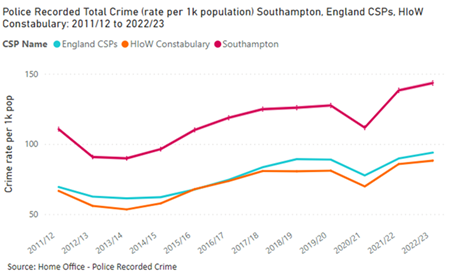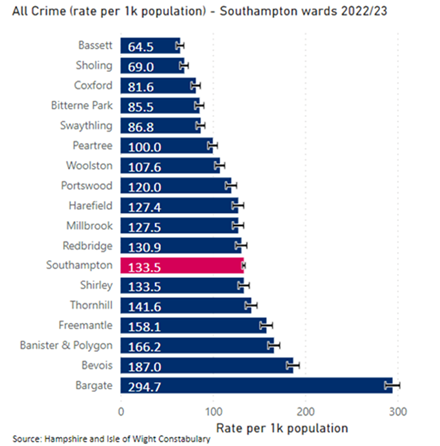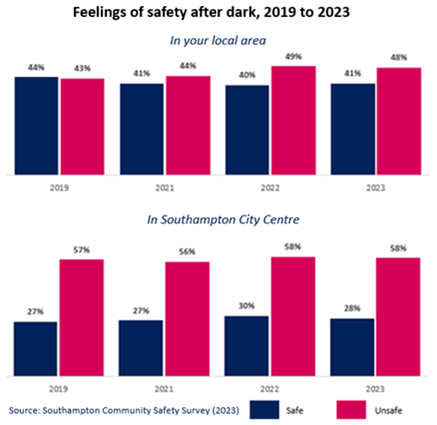
Crime
 Total crime
Total crime
Police recorded crime figures include notifiable offences that have been reported to and recorded by the police. Therefore, police recorded crime does not capture all crimes that occur, with some types of crimes more likely to be underreported than others.
There were 35,485 police recorded crimes in Southampton during 2022/23, which is an increase of +3.8% (+1,296 crimes) compared to the previous year (2021/22). This increase is in line with local and national trends, with Hampshire and Isle of Wight Constabulary experiencing a +2.8% increase and England (excluding Devon and Cornwall Police) a +4.6% increase over the same period.
The increase in total recorded crime over recent years may not reflect a ‘true’ increase in crime, as recorded crime can be influenced by improved awareness of key issues, more people reporting crime and improvements in recording by the police. Additionally, the Crime Survey for England and Wales estimates that total crime decreased by -15% in the year ending March 2023 compared to the pre-pandemic baseline. The 2023 community safety survey also found no significant change in reported victimisation compared to before the pandemic.
However, it is important to note that changes in the volume of crimes vary across different crime groups. Additionally, police recorded crime only includes crimes that have been reported to and recorded by the police, with ‘hidden’ crimes such as domestic abuse far more likely to be underreported than other offences such as theft.
A crime prioritisation scoring exercise highlighted the following crime groups as a priority for the Partnership:
- Theft offences
- Sexual offences
- Violent crime
- Domestic crimes
Theft offences emerged as a top priority for the first time in 2022/23, given increases in both volume and severity, likely linked to the cost of living crisis. Whereas, sexual offences, violent crime and domestic crimes have consistently featured among the top priorities in the last five years.
Crime distribution within the city
Studies have consistently found strong links between risk factors such as poverty and crime. Poverty alone does not cause criminal behaviour or victimisation but generates material and social conditions that mean that people living in poorer neighbourhoods are generally more likely to be the victims and/or the perpetrators of crime. Therefore, as poverty and other risk factors vary across the city, so will the frequency and relative severity of crime.
The crime rate in Southampton varies considerably by electoral ward. Bargate ward had the highest rate of crimes per resident population in 2022/23. As a central ward, Bargate has large shopping areas and high numbers of night-time economy venues, which are associated with particular crime types and crimes affected by alcohol. Bassett and Sholing wards have the lowest rate of offences, with these wards containing some of the most affluent neighbourhoods in the city. More information can be found in the deprivation and poverty page.
What do residents say?
Feelings of safety in the community are important, as residents should be able to go about their daily activities without fear of crime or harm. The 2023 Southampton community safety survey was carried out by Southampton City Council from 22nd August 2023 to 18th September 2023 to elicit the views of people living, studying and working in the city on community safety issues.
The majority of people who responded to the survey in 2023 felt crime had increased in the last 12 months (59%), with just 2% of respondents feeling it had declined. Over a third (37%) of respondents reported being a victim of crime or anti-social behaviour in Southampton during the last 12 months. Just 14% of respondents to the 2023 survey agreed that the police and other local public services were successfully dealing with crime and anti-social behaviour in their local area.
Survey respondents were asked about feelings of safety in their local area and the city centre. The majority of respondents in the 2023 survey felt safe during the day in their local area (77% felt safe) and in the city centre (65% felt safe). Respondents felt less safe after dark, particularly in the city centre; two-fifths (41%) of respondents felt safe after dark in their local area compared to less than a third (28%) feeling safe after dark in the city centre. Feelings of safety after dark remain a substantial issue in Southampton, with women and people with disabilities feeling the most unsafe.
A summary report and slide set produced as part of the 2022/23 Strategic Assessment are available to download below. The interactive community safety dashboard can be accessed using the link below. For more information on crime in Southampton, see the Safe City Strategic Assessment page.
Resources
2022/23 Safe City Strategic Assessment
The Southampton Safe City Strategic Assessment provides an overview of current and future crime, disorder and community safety issues affecting Southampton and makes recommendations to enable the Partnership to focus the Safe City Strategy and local delivery plans. The report and slide set that informed the assessment are available below to download. The interactive community safety dashboard can be accessed using the link below.
Archived assessments
This section contains archived reports from previous Safe City Strategic Assessments. For the latest report and data on crime and community safety in the city, see the Safe City Strategic Assessment above.
ONS - Crime in England and Wales
The Office for National Statistics (ONS) publish a quarterly report assessing crime in England and Wales using data from police recorded crime and the Telephone-operated Crime Survey for England and Wales. The report most relevant to the latest Southampton Safe City Strategic Assessment is linked below.
data.police.uk
This site provides open street-level crime, outcome and stop-search datasets for police force areas across England, Wales and Northern Ireland.
Last updated: 14 December 2023


